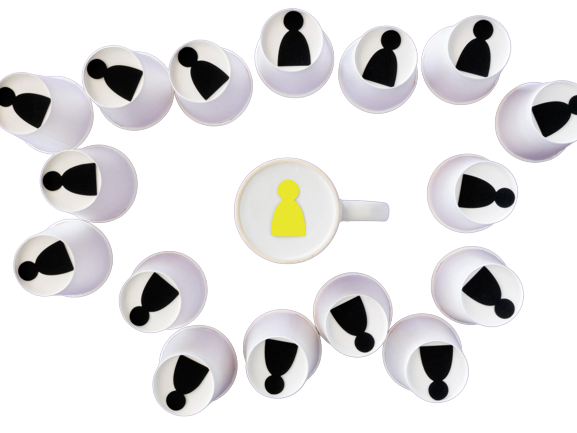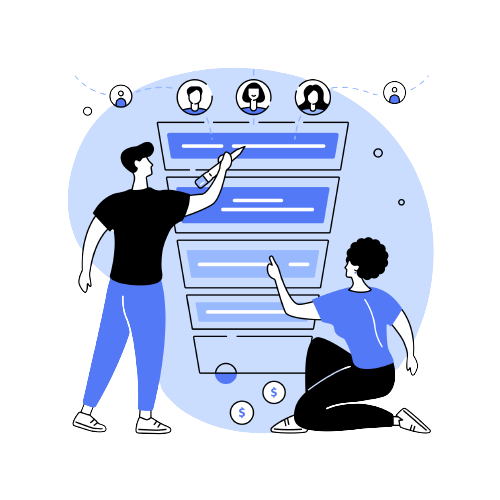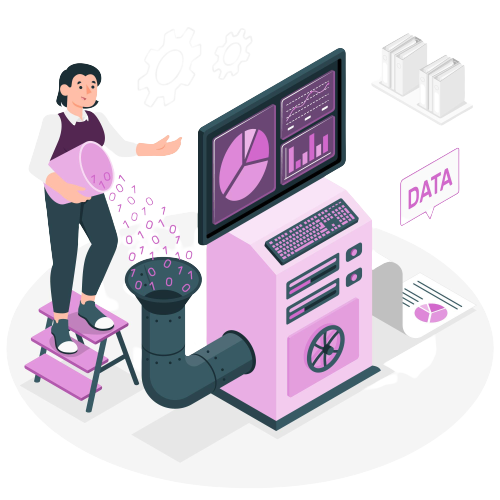
Today, businesses are constantly striving to forge meaningful connections with their customers. Gone are the days of generic, one-size-fits-all marketing campaigns that cast a wide net but yield limited results.
As the consumer demands personalized experiences and relevant content continue to surge, savvy marketers have turned their attention to a game-changing strategy: user segmentation in marketing automation.
Imagine a marketing approach that allows you to understand each customer on an individual level – their needs, preferences, and behaviors – and then tailor your messaging accordingly, ensuring that each interaction resonates deeply.
This is the essence of user segmentation, a sophisticated yet accessible technique that empowers businesses to deliver targeted, personalized campaigns that drive engagement, loyalty, and ultimately, revenue.
In this comprehensive guide, we will dive deep into the world of user segmentation in marketing automation. Whether you’re a marketing novice eager to explore the possibilities or an experienced professional seeking to refine your approach, this blog is your compass to navigate the dynamic terrain of personalized marketing strategies.
What is User Segmentation and Why It Matters in Marketing Automation?

User segmentation is a powerful marketing strategy that involves dividing a company’s customer base into distinct groups or segments based on specific characteristics, behaviors, or preferences. These segments help marketers create targeted and personalized marketing campaigns that resonate with each group’s unique needs and interests.
By understanding the diverse needs of different customer segments, businesses can tailor their messages, offers, and promotions to be more relevant and compelling, ultimately leading to improved customer engagement, satisfaction, and loyalty.
Let’s understand why user segmentation matters in marketing automation.

- Personalization and Relevance: User segmentation allows marketers to personalize their interactions with customers, offering content, products, and services that align with individual preferences. When customers receive tailored messages that cater to their specific interests, they are more likely to engage with the brand and feel valued, leading to increased trust and loyalty.
- Improved Customer Experience: By using user segmentation in marketing automation, businesses can create customer journeys that are seamless and intuitive. Customers are guided through a series of interactions that match their needs, making the overall experience more enjoyable and convenient. This, in turn, can lead to higher customer satisfaction and a positive perception of the brand.
- Enhanced Targeting and Acquisition: Segmentation allows businesses to identify high-potential customer groups or market segments. By understanding the distinct characteristics and behaviors of these segments, marketers can tailor their acquisition efforts and promotional activities to reach the right audience with the right message, resulting in higher conversion rates and more efficient marketing spending. It can be possible through marketing automation.
- Retention and Customer Loyalty: Customer retention is critical for long-term business success. User segmentation enables businesses to identify and address the specific pain points of different customer segments. By providing solutions that resonate with customers’ unique needs, businesses can boost customer satisfaction and foster loyalty, reducing churn rates and increasing customer lifetime value.
- Optimal Resource Allocation: Marketing resources are finite, and it is essential to allocate them wisely to achieve the best results. User segmentation helps businesses focus their efforts and resources on the most promising customer segments, ensuring that marketing initiatives are more cost-effective and efficient. Marketing automation can make it possible
- Data-Driven Decision Making: User segmentation relies heavily on data analysis to identify patterns and insights. By leveraging data-driven decision-making, businesses can make informed choices about their marketing strategies, ensuring that their efforts are rooted in real customer behavior and preferences rather than guesswork.
- Adaptability and Agility: Markets and customer preferences are constantly changing. User segmentation allows businesses to adapt quickly to these changes by identifying emerging trends or shifts in customer behavior. This agility enables marketers to respond proactively, staying ahead of the competition and delivering relevant messaging to customers.
- Customer Feedback and Innovation: User segmentation also facilitates gathering feedback from different customer segments. By understanding their opinions and preferences, businesses can use this feedback to improve products and services, implement new features, and develop innovative solutions like marketing automation that meet customers’ evolving needs.
User segmentation plays a crucial role in marketing automation by enabling businesses to understand their customers on a deeper level. By harnessing the power of data and the best marketing automation software, user segmentation empowers marketers to make strategic decisions that drive growth and success in a dynamic and ever-changing marketplace.
Benefits of Implementing User Segmentation in Your Marketing Strategy

Implementing user segmentation in your marketing strategy can bring a plethora of benefits that can significantly impact your business’s success. By dividing your audience into distinct segments based on shared characteristics, preferences, and behaviors, user segmentation allows you to craft targeted and personalized marketing campaigns that resonate deeply with each segment. Here are some benefits of implementing user segmentation using marketing automation software in your marketing strategy:
- Enhanced Personalization: By understanding their unique needs and interests, you can tailor your messaging, offers, and content to match their preferences using marketing automation.
- Improved Customer Experience: When customers receive relevant content and offers that align with their interests, they feel valued and understood. This leads to an improved customer experience, which can result in higher customer satisfaction and advocacy.
- Higher Conversion Rates: When your messaging directly addresses the pain points and needs of specific segments through a marketing automation tool, it increases the chances of them taking action.
- Increased Customer Retention: By offering targeted incentives, loyalty rewards, or exclusive content, you can strengthen customer loyalty and retention.
- Optimal Resource Allocation: Instead of a scattergun approach, you can focus your efforts on the segments that have the highest potential for conversion. This ensures that your budget is spent wisely, maximizing your marketing ROI.
- Better Customer Insights: By analyzing each segment separately using marketing automation, you can identify patterns and trends that might not be evident in the overall data.
- Competitive Advantage: Businesses that implement effective segmentation strategies can stand out by delivering superior customer experiences, driving customer loyalty, and outperforming competitors.
Embracing user segmentation as a core component of your marketing strategy can lead to long-term success and help your business thrive using marketing automation software.
Understanding Different Types of User Segmentation

There are several types of user segmentation, each offering unique insights into your audience. By understanding the different types of user segmentation, you can create more targeted and personalized marketing campaigns, leading to better engagement, higher conversion rates, and increased customer satisfaction through the Top 10 Best Marketing Automation Software Comparison.
Let’s delve into some of the most common and effective approaches:
Demographic Segmentation
Demographic segmentation involves dividing your audience based on demographic factors such as age, gender, location, income, education, and marital status. This type of segmentation provides a basic understanding of your customers’ characteristics and helps you tailor your messages to resonate with specific demographic groups. For example, using marketing automation, a clothing retailer might target different age groups with distinct fashion styles or create location-specific promotions to appeal to customers in specific regions.
Behavioral Segmentation
Behavioral segmentation categorizes customers based on their actions and interactions with your brand. It involves analyzing data related to past purchases, website browsing behavior, email engagement, and social media interactions. By segmenting customers using marketing automation tools according to their behavior, you can identify high-value customers, engage with potential churners, and create personalized recommendations based on their preferences. For instance, an e-commerce platform might target frequent buyers with loyalty rewards, while re-engaging dormant customers with special discounts.
Psychographic Segmentation
Psychographic segmentation focuses on understanding customers’ attitudes, interests, and lifestyles. This approach goes beyond basic demographics and explores the emotional and psychological factors that influence purchasing decisions. By segmenting through a marketing automation system based on psychographics, you can create messaging that aligns with your customer’s values and interests. For instance, a fitness brand might target health-conscious individuals who value eco-friendly products, tailoring their campaigns to highlight sustainability and health benefits.
Geographic Segmentation
Geographic segmentation involves dividing your audience based on their geographical location. This type of segmentation is particularly useful for businesses with a physical presence in different regions or offering location-specific products or services. By understanding regional preferences and needs using marketing automation software, you can create region-specific marketing campaigns and promotions. For example, a fast-food chain might adapt its menu to include regional favorites in different locations.
Purchase Stage Segmentation
Purchase stage segmentation classifies customers based on where they are in the buyer’s journey. This approach allows you to send relevant messages at each stage of the customer’s decision-making process. For example, new leads might receive educational content and introductory offers, while those close to making a purchase might receive limited-time discounts to incentivize them to take action.
Customer Lifetime Value Segmentation
Customer Lifetime Value (CLV) segmentation involves categorizing customers based on their potential long-term value to your business. Customers with higher CLV are those who make frequent purchases, remain loyal, and refer others to your brand. By segmenting based on CLV through marketing automation, you can allocate resources more efficiently, focusing on retaining and nurturing high-value customers while optimizing efforts for those with lower CLV.
Firmographic Segmentation
Firmographic segmentation is primarily relevant for B2B (business-to-business) marketers and involves segmenting customers based on company-related characteristics. This may include company size, industry, revenue, location, or years in business. By understanding the specific needs and challenges of different businesses, B2B marketers can create targeted content and solutions tailored to each segment’s requirements.
It’s important to note that user segmentation is not limited to just one type. The most effective marketing automation strategies often combine multiple segmentation approaches to gain a comprehensive understanding of their audience. By leveraging various segmentation criteria, businesses can create highly personalized and relevant marketing campaigns that speak directly to their customer’s needs and desires.
Data Collection and Analysis for User Segmentation

To implement successful segmentation, a crucial foundation must be laid – data collection and analysis. In this section, we will delve into the art and science of gathering relevant data and deriving meaningful insights to fuel your user segmentation endeavors through marketing automation.
Data is the lifeblood of user segmentation. It provides the necessary information to divide your diverse audience into distinct segments based on shared characteristics, behaviors, and preferences. By understanding your customers’ unique traits and interactions with marketing automation, you can craft highly tailored messages that speak directly to their needs, increasing the likelihood of engagement and conversion.
1. Identifying and Collecting Relevant User Data
The first step in data-driven user segmentation is identifying the relevant data points to collect. Different businesses may require varying types of data, depending on their industry, products, and target audience. Some essential data sources include:
- Demographic Information: This includes age, gender, location, income, and other factors that help group users based on their shared characteristics.
- Behavioral Data: Analyzing how users interact with your website, mobile app, or emails provides insights into their preferences, interests, and purchase behavior.
- Psychographic Data: Understanding users’ values, attitudes, and lifestyle choices can help create more personalized and emotionally resonant marketing campaigns.
- Customer Feedback: Surveys, reviews, and feedback provide direct insights into customers’ satisfaction levels and pain points.
- Social Media Interactions: Monitoring social media platforms can reveal sentiments and interests shared by users.
- Purchase History: Analyzing customers’ past purchases can help predict future preferences and buying patterns.
- Customer Support Interactions: Data from customer support interactions can offer valuable feedback and identify areas for improvement.
It’s essential to gather data from multiple sources to create a holistic view of your customers and their interactions with your brand. You can also get this data from the best marketing automation software.
2. Tools and Techniques for Data Analysis
With a treasure trove of data at your disposal, the next step is to analyze it effectively. Various tools and techniques can aid in extracting valuable insights:
- Data Analytics Platforms: Utilize data analytics platforms like Google Analytics, Adobe Analytics, or Mixpanel to track user behavior on your digital properties.
- Customer Relationship Management (CRM) Systems: CRM systems store customer information and can help you segment users based on their interactions with your brand.
- Machine Learning Algorithms: Advanced machine learning algorithms can discover patterns and trends in large datasets, providing more accurate segmentation.
- Data Visualization: Presenting data through visualizations such as charts and graphs can make complex information more accessible and actionable.
- A/B Testing: Conduct A/B tests to compare the performance of different marketing strategies and identify which segments respond better to specific approaches.
Marketing automation software can help you with some of the above-mentioned insights.
3. Key Metrics to Consider for User Segmentation
To create effective segments, certain key metrics must be considered during data analysis:
- Conversion Rates: Measure how well different segments convert from leads to customers.
- Customer Lifetime Value (CLV): Determine the long-term value of customers within each segment.
- Engagement Metrics: Analyze user interactions, such as time spent on site, click-through rates, and email open rates.
- Churn Rate: Monitor how many customers leave each segment over time.
- Return on Investment (ROI): Measure the effectiveness of your marketing campaigns within each segment.
You can get information about these key metrics through marketing automation.
4. Overcoming Challenges in Data Collection and Analysis
Data collection and analysis come with challenges, including:
- Data Privacy and Security: Ensure compliance with data protection regulations and prioritize data security.
- Data Quality: Verify data accuracy and address any inconsistencies to avoid erroneous insights.
- Data Integration: Merge data from various sources to create a comprehensive view of customers.
- Data Bias: Be aware of potential biases in the data that could impact the accuracy of segmentation.
As businesses continue to embrace the potential of user segmentation, leveraging data effectively using marketing automation software will be the key to unlocking the true power of personalization in modern marketing strategies.
Common Mistakes to Avoid in User Segmentation

When executed correctly, user segmentation can lead to more personalized and relevant marketing campaigns that resonate with customers, driving higher engagement and conversion rates. However, like any marketing tactic, user segmentation comes with its own set of challenges, and making mistakes is a part of the learning process.
It’s time to discuss some common mistakes to avoid in user segmentation, ensuring that your efforts yield the desired results and effectively connect with your audience.
- Neglecting Data Quality and Accuracy: One of the most significant mistakes in user segmentation is relying on inaccurate or outdated data. If your segmentation is based on incorrect information, it can lead to targeting the wrong audience, resulting in wasted resources and missed opportunities. To avoid this, invest time in regular data cleaning and validation. Ensure that data sources are reliable and up-to-date, and use data analytics tools to extract meaningful insights.
- Overlooking Behavior-Based Segmentation: While demographic segmentation is a common starting point, relying solely on demographics can be limiting. Neglecting behavior-based segmentation can prevent you from understanding the unique preferences and actions of your audience. Incorporate user behavior data, such as website interactions, purchase history, and engagement patterns, into your segmentation strategy. Behavior-based segmentation enables you to craft targeted campaigns that cater to specific user actions, leading to better results.
- Creating Too Many Segments: Segmentation can become counterproductive when there are too many segments to manage effectively. Over-segmentation can lead to diluted efforts and fragmented marketing campaigns. It is essential to strike a balance and create segments that are distinct enough to be relevant, but not so granular that they become challenging to manage. Regularly review and refine your segments to ensure they align with your marketing objectives.
- Failing to Test and Optimize: Effective segmentation requires continuous testing and optimization. Not analyzing the performance of your segmented campaigns can result in missed opportunities for improvement. Implement A/B testing to compare different segmentations and messaging strategies. Analyze the results to identify what works best for each segment and make data-driven adjustments accordingly.
- Ignoring Customer Feedback and Preferences: Customer feedback is a valuable resource in user segmentation. Ignoring customer preferences and sentiments can lead to campaigns that miss the mark. Engage with your audience through surveys, feedback forms, and social media interactions to understand their preferences better. Tailor your messaging and offers based on this feedback to create more relevant campaigns that resonate with your customers.
- Not Considering Seasonality and Trends: Failing to account for seasonality and trends can hinder the effectiveness of your segmentation efforts. Customer behavior often varies based on the time of year and current trends. Take these factors into consideration when crafting segmented campaigns to ensure that your messaging remains timely and relevant.
- Lack of Integration and Collaboration: Effective user segmentation requires collaboration between different teams within your organization. Often, marketing teams work in isolation from sales, customer service, and product development teams, leading to fragmented strategies. Encourage cross-functional collaboration to gain a comprehensive understanding of customer behavior and preferences across all touchpoints, resulting in a more cohesive and effective segmentation approach.
Avoiding these common mistakes and continuously refining your segmentation strategy using marketing automation software will enable you to unlock the full potential of personalized marketing, creating meaningful connections with your audience and driving sustainable business growth.
In The Nutshell!
Mastering the art of user segmentation is a transformative journey that empowers businesses to connect with their customers on a profound level. As we conclude this enlightening guide on “How to Get Started with User Segmentation in Marketing Automation,” we have unveiled the immense potential this strategy holds for creating personalized, engaging, and impactful campaigns.
By understanding the unique needs, preferences, and behaviors of your audience, you gain a powerful advantage – the ability to tailor your messaging with precision and create experiences that leave a lasting impression. As the demands for personalized marketing continue to shape the marketing landscape, user segmentation emerges as the North Star guiding businesses toward stronger customer connections and sustainable growth.
We have learned from common mistakes and gained valuable insights to refine our approaches continually. With each step, we’ve emphasized the importance of listening to our customers, valuing their feedback, and integrating segmentation throughout the customer journey.
Be open to experimentation and iteration, as refining your segmentation approach is an ongoing process that allows you to adapt and thrive in a dynamic marketplace. Now armed with the knowledge and tools to harness the power of user segmentation in your marketing automation, you possess the keys to unwrap the full potential of personalization.